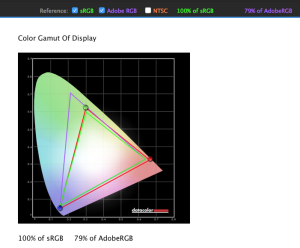
I originally wanted to devote at least one story to a qualitative analysis of the Retina iMac’s screen, including a list of physical measurements (gamut, gamma, intensity, and anything else I could measure). However, although I measured like a crazy fiend, my hopes of a constructive analysis were dashed when my expert—Dr. Ray Soneira of DisplayMate—told me that the data gathered was mostly unusable. Primarily, it's due to my choice of instruments. Sadly, our Spyder4 Elite just wasn’t quite up to the task.
"Your Spyder measurements indicate that the Color Gamut is close but not accurate enough for video production. The most likely reason is that the Spyder is inaccurate because Apple most likely did a better job of accurately calibrating the monitor. The 1931 CIE Diagram that you use is highly non-uniform and obsolete," Soneira said.
However, he gamely took a look through the results anyway, and the e-mail conversation turned to resolution. Soneira quickly put forward a handy explanation for why Apple chose the "5K" resolution of 5120×2880 rather than one of the myriad of "standard" 4K resolutions. There are of course a lot of technical reasons to pick 5120×2880—at double the older 27-inch iMac’s resolution of 2560×1440, it makes for precisely four times as many pixels and easy scaling—but Soneira’s explanation was particularly insightful.
"This monitor is designed for video production, which is the primary reason for buying a 5K display as opposed to a 4K display," he said. "A 5K display is great when working on 4K content (3840×2160 or 4096×2160) because you can view all of the images at their true native 4K resolution, which is very important, and then have a fair amount of leftover extra screen space all around it for controls, icons, and even a generous 3.4-inch high text area at the bottom for commands and text input."

However, it’s not all rosy at 5K—in fact, Soneira went on to explain that while 5K is great for creating native 4K content, it’s not all that ideal for watching it. "For viewing 4K content, a native 4K is much better because the image quality is best at the native resolution of the content," he explained. Upscaling 4K to 5K inevitably results in some artifacting. "In fact," he continued, "4K has 8.3MP, but 5K has 14.7MP, so a 4K image only uses 56 percent of a 5K screen. There is no advantage to having a 5K Cinema display—in fact, it wouldn't be quite as good as a native 4K Cinema display for viewing 4K content."
All things being equal, though, making the iMac’s display 5K instead of 4K sounds like the right call—preserving content fidelity during production is definitely a good enough reason not to use a "standard" 4K resolution size.
reader comments
127